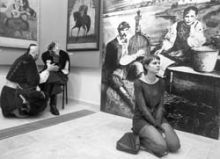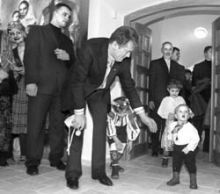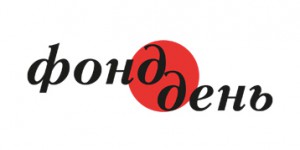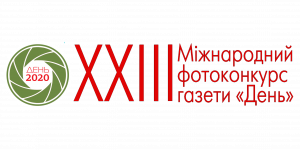On March 26, the Ukrainian folk culture center at Kyiv’s Ivan Honchar Museum hosted “Pisni Vechornytsi,” an improvised version of the Ukrainian traditional folk event that literally means “Lenten night gathering.” The idea belongs to Oleh Skrypka, the lead singer of the widely popular Ukrainian band Vopli Vidopliasova (VV). It has been the twelfth vechornytsi in the past six months. Its format is different each time, enriched with new ideas and elements. According to Oleh Skrypka, his project is not an attempt at meticulous reconstruction of the folk tradition, but rather his own improvisation. Vechornytsi used to have both Christian and ritualistic meaning. Preparing for Easter during the Great Lent, our ancestors also marked the arrival of spring. They gathered at a neighbor’s house, where the women prepared lean dishes which they served to men and boys; sang vesnianky [traditional spring songs], and rehearsed hayivky and hahilky, songs sang outside the church on Easter. The children practiced the art of egg-painting.
At Oleh Skrypka’s vechornytsi folk groups Bozhychi, Khreshchaty Yar, and Hurtopravtsi performed round dances, singing old vesnianky that they recorded during their field trips in central and eastern Ukraine. Teenagers learned to paint Easter eggs, while younger children made papier-mЙchО eggs and painted them with watercolors. Hostesses prepared dough for ritual cookies called zhaivoronky [skylarks]. In olden times this bird was considered a harbinger of spring. They also served lean salads, pastry, stewed dry fruit, pumpkin seeds, etc. This time there were more guests than usual. Among them were famous artists, producers, actors, publishers, singers, and musicians. It is obvious that the project is gaining in popularity. “In Poland, for example, folk art is all the rage now, Ukrainian folk art included,” says Warsaw University professor Rostyslav Kramar. “The Ukrainian musical folk art attracts Western neighbors with its multiloquence, which their culture lacks. There are many bands, such as Z Dorohy, or the choir Verkhovyna, in which Poles sing Ukrainian songs. And they are a crowd puller!” Everybody was waiting for the president’s family to arrive. Even before his presidency Viktor Yushchenko attended such gatherings. He is a regular fixture at Malanka, a celebration of the Ukrainian folk holiday of the same name, which is organized every year by the Lviv community in Kyiv.
Viktor and Kateryna Yushchenko and their children arrived with the wife of the Georgian president to show her how Ukrainian traditions are being revived. The guests did not overlook the Ivan Honchar Museum with its collection of over 15,000 items of Ukrainian culture: folk paintings, icons, embroidery, traditional clothing, and earthenware. “The Georgian delegation has left, but I have remained to see this folk holiday,” Sandra Saakashvili told The Day.
“I’m curious to find out how Ukrainians live in anticipation of Easter. Days before Easter, Georgians paint eggs and take them along with Easter bread and, of course, wine to the cemetery.”
Kateryna Yushchenko brought a basketful of fresh baked skylark cookies, each containing a message: “The world was after me, but failed to catch me” — Hryhory Skovoroda, “Let everything unseen be seen,” “Let everything forgiven be forgotten” — Lina Kostenko, etc. These poetic lines are wishes for the whole year until the next spring.
For some time the only active participants of the vechornytsi were folk groups and hostesses, while the remaining guests watched one-year-old Taras Yushchenko attempting his first steps and Viktor Yushchenko and his daughter Sophiya painting Easter eggs. Later all guests of honor did a painting in the genre of folk naпve: a hut with a thatched roof, a deer, and a swan lake.
The vechornytsi continued long after the Yushchenkos and Sandra Saakashvili had left. In one room Taras Kompanychenko played his kobza in a company of admiring listeners. In another room Serhiy Boot performed an enchanting solo on his violin. “Thanks to the vechornytsi the traditional village culture will find forms of expression in cities,” says Rostyslav Kramar. “After all, most first or second generation Ukrainians come from villages. After striking root in the capital or oblast centers they were not always able to preserve their identity. This has created many problems in society, including the language problem. Oleh Skrypka’s project is one of the ways to find our identity in an urban setting. In effect, we are creating a new face for the Ukrainian metropolis.” The producer Les Sanin recalls that the Ivan Honchar Museum has always been a magnet for people: “Here one can talk or keep silent. ‘How are you?’ ‘Fine.’ ‘How are the children?’ ‘Fine, thank God.’ This miniature dialog reflects Ukrainian history, when people understood one another without words. Those who come here sense that they have something in common. And this common thing is reflected in icons, embroidery, and clothing. They carry the code of the Ukrainian DNA, which is also present in our vechornytsi that have gathered so many people. I hope that there will be more and more such people and fewer accidental guests among them.”
The annual cycle of the vechornytsi will culminate in the ethnic festival “Land of Dreams” in early July. Aside from folklore groups from across Ukraine and elsewhere, the organizers have promised to present cuisines from different parts of Ukraine. According to Ukraine’s Culture and Arts Minister Oksana Bilozir, the government has already decided to support this festival financially.









